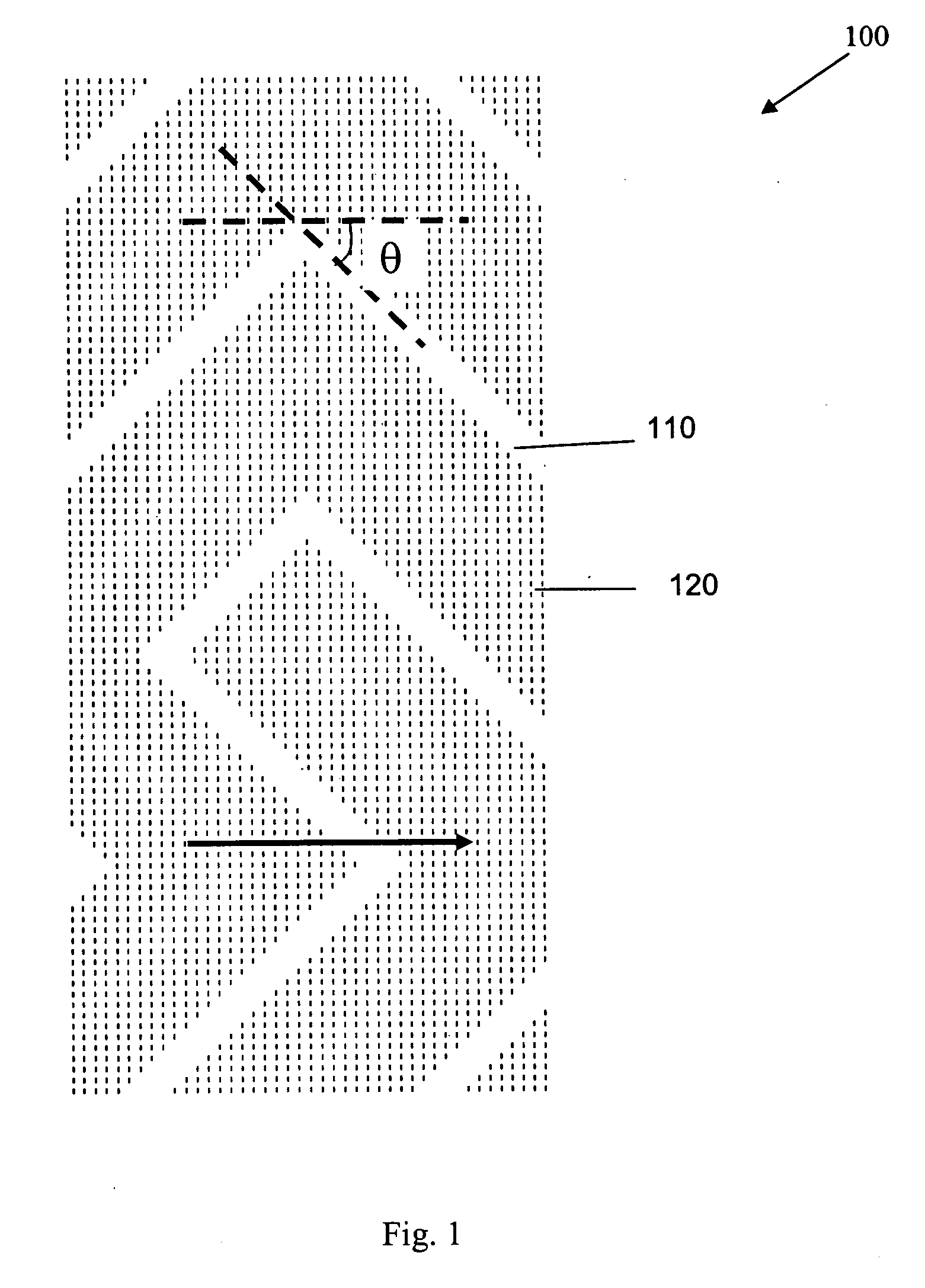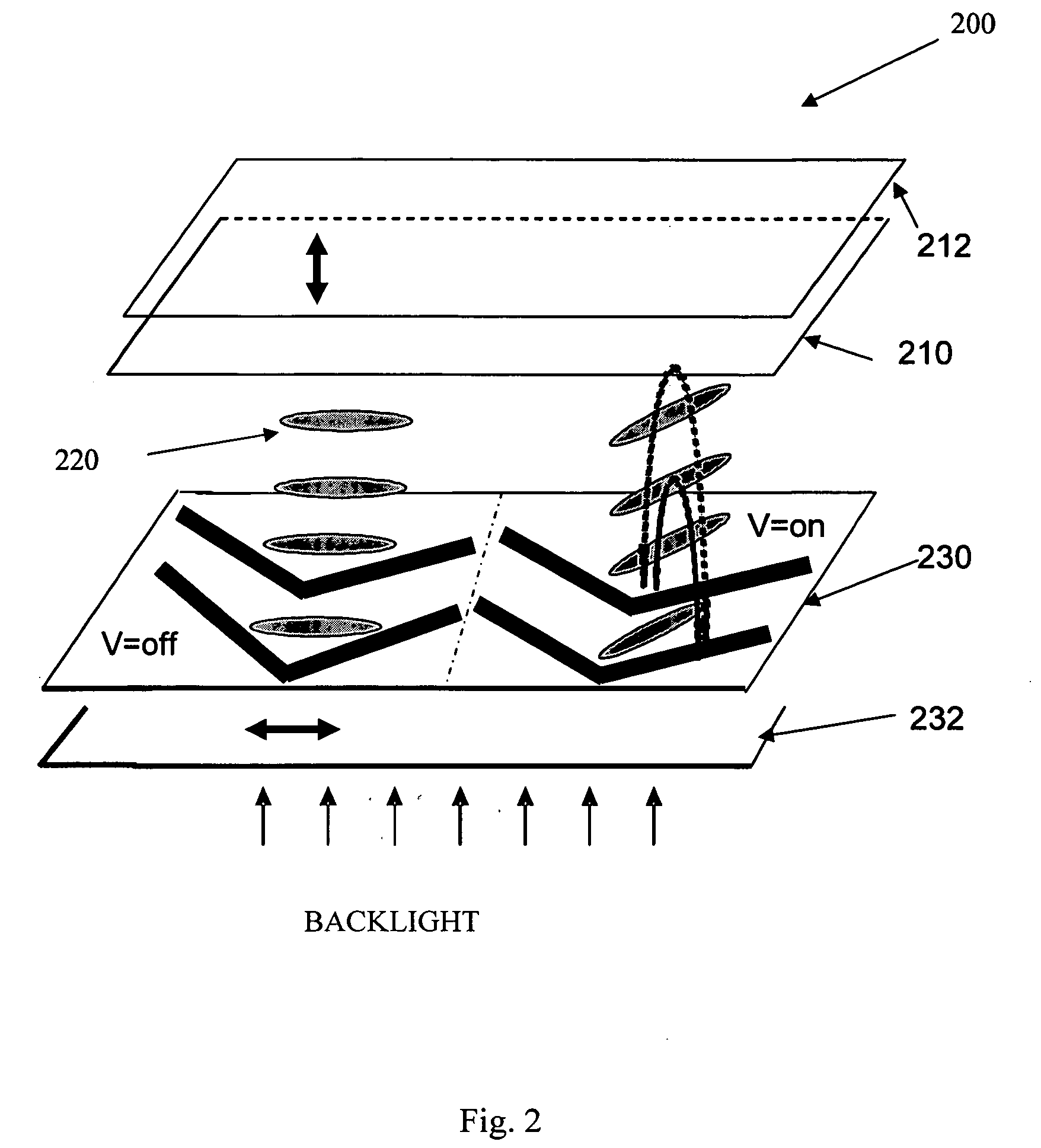Multi-domain in-plane switching liquid crystal displays
- Summary
- Abstract
- Description
- Claims
- Application Information
AI Technical Summary
Benefits of technology
Problems solved by technology
Method used
Image
Examples
embodiment 1
[0058]FIGS. 1 and 2 illustrate the typical chevron-shaped electrode structure and the corresponding device structure and operation when using the homogeneously aligned liquid crystals. The electrode structure 100 consists of the chevron-shaped electrodes in both the horizontal and vertical directions which divides the electrode structure into at least two regions. A series of chevron-shaped electrodes are alternatively arranged to form the inter-digital electrodes on the same substrate as the common electrode 110 and the pixel electrode 120, respectively, which are connected to the thin-film transistors (not shown). The common electrode 110 and the pixel electrode 120 can be formed using the same photolithography process, or prepared respectively and separated by passivation layers such as SiO2. The distance between adjacent common electrodes 110 and pixel electrodes 120 can be larger than the cell gap for in-plane switching or smaller than the cell gap to take advantage of the frin...
embodiment 2
[0066] As previously described, FIG. 3 illustrate a typical chevron-shaped electrode structure and corresponding general device structure of a chevron-shaped multi-domain in-plane-switching LCD using vertically aligned liquid crystals. The electrode structure consists of the chevron-shaped electrodes in the horizontal and vertical directions which divide the electrode structure into at least two regions. A series of chevron-shaped common electrodes and chevron-shaped common electrodes are alternately arranged to form the inter-digital electrodes one of the substrates and are connected to the thin-film transistors. The chevron-shaped common electrode and the chevron-shaped pixel electrode can be formed using the same photolithography process, or prepared respectively and separated by passivation layers such as SiO2. At the boundary between regions, the chevron-shaped common electrodes and the chevron-shaped pixel electrodes occupy adjacent space for the fully transverse switching to ...
embodiment 3
[0072]FIG. 4 is a plan view of a general electrode structure of a chevron-shaped multi-domain in-plane-switching liquid crystal display with two uniformly aligned liquid crystal domains. The electrode structure consists of the chevron-shaped electrodes in both the horizontal and vertical directions which divides the electrode structure into at least two different regions as previously discussed in the first embodiment.
[0073] The electrode structure is divided into two parts with the different liquid crystal aligning directions, which is usually perpendicular to each other and as shown in FIG. 4 where the arrows indicate the LC alignment directions. The two initial aligned LC domains can be obtained by double rubbing method, photo-alignment method or the inkjet printing process. Since the double multi-domain in-plane-switching liquid crystal display can be regarded as two separate in-plane-switching liquid crystal display operating simultaneously, its operational mechanism is simila...
PUM
 Login to View More
Login to View More Abstract
Description
Claims
Application Information
 Login to View More
Login to View More - R&D
- Intellectual Property
- Life Sciences
- Materials
- Tech Scout
- Unparalleled Data Quality
- Higher Quality Content
- 60% Fewer Hallucinations
Browse by: Latest US Patents, China's latest patents, Technical Efficacy Thesaurus, Application Domain, Technology Topic, Popular Technical Reports.
© 2025 PatSnap. All rights reserved.Legal|Privacy policy|Modern Slavery Act Transparency Statement|Sitemap|About US| Contact US: help@patsnap.com



